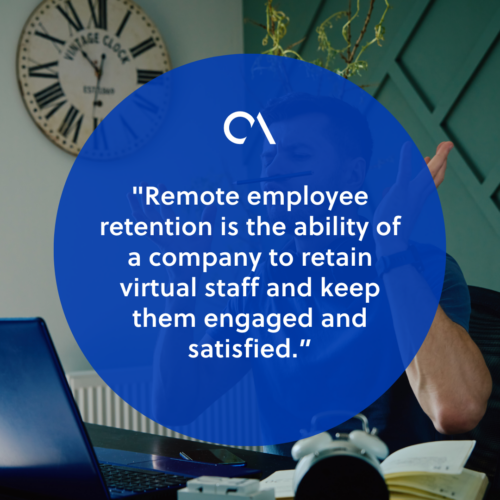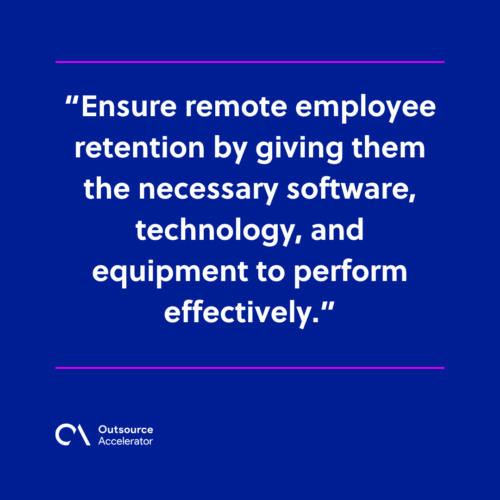5 ways to manage remote employee retention

How to drive remote employee retention
Remote work is increasingly becoming the standard, and your company should be no exception. WFH Research reported that 40% of US employees now work remotely for at least one day per week in 2023. This is nearly a five-fold increase from 2019.
Your businesses must seriously consider this new environment to ensure the longevity and satisfaction of your remote employees. This applies to both your local and offshore workers.
In this article, we examine common challenges brought by the remote work setup and some strategies that you can implement to ensure remote employee retention.
Understanding remote employee retention
Remote employee retention is the ability of a company to retain virtual staff and keep them engaged and satisfied. These involve strategies and initiatives aimed at addressing the unique challenges of a remote or hybrid setup.
For example, these can include:
- Implementing regular check-ins to provide guidance, support, and recognition
- Enabling flexible work arrangements and schedules
- Offering access to online training programs and skill-building workshops
Remote employee retention is crucial in this new work landscape. A 2022 FlexJobs survey noted that 65% of professionals preferred a fully remote arrangement, while 32% opted for a hybrid setup.

Challenges of remote employee retention
Due to the unique nature of remote work, remote employee retention must deal with these challenges to maintain a cohesive and productive workforce:
Communication issues
Remote teams may face difficulties in effectively communicating with their colleagues and supervisors due to the lack of face-to-face interaction. Misunderstandings, delays in response times, and lack of clarity can hinder collaboration and productivity.
Feelings of isolation and disengagement
Working remotely can easily lead to feelings of isolation and disconnection from the broader team. With the workday taking up most of the hours, socialization with teammates can be the most common thing people get, and removing this can be disadvantageous at times.
Remote employees may miss out on the informal interactions and connections that occur naturally in a traditional office setting. This impacts their sense of belonging and engagement.
Striking a work-life balance
All too often, remote work blurs the boundaries between work and personal life. This imbalance can contribute to burnout and reduced job satisfaction, leading to lower remote employee retention.
Technological limitations
Dependence on technology for remote work can pose challenges when technical issues arise.
These can include:
- Unreliable network connections
- Outdated tools
- Software glitches
- Compatibility issues
These impede productivity and heavily affect remote employee retention.
Difficulty in monitoring performance
Despite many adopting the practice in the last few years, some level of adjustment is still needed for this remote work era. Supervisors may find it challenging to monitor the work progress and performance of remote employees effectively.
This can make it difficult to assess productivity levels and provide necessary feedback. Additionally, the lack of visibility and networking opportunities can hinder one’s ability to progress within the organization.
5 strategies for remote employee retention
Effective strategies for remote employee retention involve facing those common issues head-on. Consider the following methods:
1. Keep communication open
Establish clear channels of communication, and make sure everyone has a clear grasp of their job responsibilities, performance expectations, and goals.
Here are a few ideas:
- Encourage open-door policies for remote employees to reach out with any questions, concerns, or ideas they may have.
- Schedule regular meetings so that remote employees and managers can provide updates, discuss progress, and address challenges.
- Utilize instant messaging platforms to facilitate quick exchange of ideas and information.
Provide them with a sense of purpose and direction, ensuring they understand how their work contributes to the company’s overall success.
2. Encourage social connections
Facilitate opportunities for remote employees to connect with their colleagues and build relationships outside of work-related tasks.
You may hold activities like:
- Virtual team-building
- Informal social gatherings
- Online communities
These events can help remote workers feel part of a cohesive team and strengthen bonds with their peers.
You can also use these events as a time to recognize and appreciate their efforts.
3. Support work-life balance
Support work-life balance by encouraging breaks and time off when needed. Make sure your remote employees set boundaries between work and personal life to promote balance and well-being.
4. Provide adequate tools and resources
Ensure remote employee retention by giving them the necessary software, technology, and equipment to perform effectively. Additionally, offer training and support for these tools and platforms.
Consider these suggestions:
- Supply the necessary hardware, such as laptops and monitors.
- Offer software subscriptions and licenses for essential tools and applications, which may include project management software and communication tools.
- If possible, consider reimbursing or subsidizing the cost of high-speed internet to ensure reliable connectivity.

5. Offer opportunities for career development and growth
Show a commitment to the professional growth of your remote employees. Invest in training programs, mentoring, and skill-building workshops to enhance their career prospects and even long-term success.
Benefits of retaining remote employees
Remote employee retention is crucial for organizations for several reasons:
Cost savings
Remote employee retention saves costs associated with recruitment, onboarding, and training. It’s more cost-effective to retain experienced workers than constantly acquiring new ones.
Gallup estimates that voluntary turnover for regular employees costs the US a trillion dollars per year. Retaining these employees would be the preferable option to the cost of hiring and training new ones.
You’ll save more money through remote employee retention. By partnering with a firm like Remote Employee, you can further reduce costs by 50-70%.
Continuity and consistency
When remote employees stay within a company for longer periods, they become well-versed in their roles and establish efficient workflows.
This results in less turnover-related disruption, leading to smoother operations and better outcomes.
Knowledge retention
Experienced remote employees possess valuable knowledge and institutional memory that can be difficult to replace. This includes information about the company, its processes, and its clients.
Retention reduces the risk of knowledge loss, which is beneficial for growth.
Employee morale and engagement
When remote employees feel valued, they’re more likely to be motivated in their work. Retention strategies that prioritize well-being and recognition contribute to higher job satisfaction and morale.
Company reputation
A high remote employee retention rate reflects positively on the organization’s reputation as an employer. A positive reputation attracts top talent and positions you as an employer of choice in your industry.
How Remote Employee supports retention
Remote Employee is a premier outsourcing company that allows you to build a team of dedicated talent.
It supports remote employee retention through the following qualities:
- Access to a pool of skilled remote professionals
- Expertise in managing remote teams effectively
- Customized solutions tailored to client needs
Get in touch with Remote Employee today!







 Independent
Independent




